
Vampire bats, members of the subfamily Desmodontinae, are leaf-nosed bats currently found in Central and South America. Their food source is the blood of other animals, a dietary trait called hematophagy. Three extant bat species feed solely on blood: the common vampire bat, the hairy-legged vampire bat, and the white-winged vampire bat. Two extinct species of the genus Desmodus have been found in North America.

Horseshoe bats are bats in the family Rhinolophidae. In addition to the single living genus, Rhinolophus, which has about 106 species, the extinct genus Palaeonycteris has been recognized. Horseshoe bats are closely related to the Old World leaf-nosed bats, family Hipposideridae, which have sometimes been included in Rhinolophidae. The horseshoe bats are divided into six subgenera and many species groups. The most recent common ancestor of all horseshoe bats lived 34–40 million years ago, though it is unclear where the geographic roots of the family are, and attempts to determine its biogeography have been indecisive. Their taxonomy is complex, as genetic evidence shows the likely existence of many cryptic species, as well as species recognized as distinct that may have little genetic divergence from previously recognized taxa. They are found in the Old World, mostly in tropical or subtropical areas, including Africa, Asia, Europe, and Oceania.

The New World leaf-nosed bats (Phyllostomidae) are bats found from southern North America to South America, specifically from the Southwest United States to northern Argentina. They are ecologically the most varied and diverse family within the order Chiroptera. Most species are insectivorous, but the phyllostomid bats include within their number true predatory species and frugivores. For example, the spectral bat, the largest bat in the Americas, eats vertebrate prey, including small, dove-sized birds. Members of this family have evolved to use food groups such as fruit, nectar, pollen, insects, frogs, other bats, and small vertebrates, and in the case of the vampire bats, even blood.

The Rainbow Serpent or Rainbow Snake is a common deity often seen as the creator God, known by numerous names in different Australian Aboriginal languages by the many different Aboriginal peoples. It is a common motif in the art and religion of many Aboriginal Australian peoples. Much like the archetypal mother goddess, the Rainbow Serpent creates land and diversity for the Aboriginal people, but when disturbed can bring great chaos.

The serotine bat, also known as the common serotine bat, big brown bat, or silky bat, is a fairly large Eurasian bat with quite large ears. It has a wingspan of around 37 cm (15 in) and often hunts in woodland. It sometimes roosts in buildings, hanging upside down, in small groups or individually. The name serotine is derived from the Latin serotinus, which means 'evening', while the generic name derives from Greek ἔπιεν and οίκος, which means 'house flyer'.
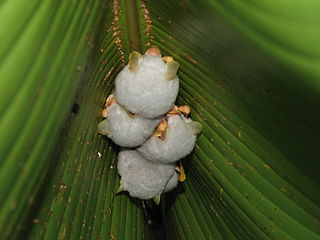
The Honduran white bat, also called the Caribbean white tent-making bat, is a species of bat in the family Phyllostomatidae. It is the only member of the genus Ectophylla. The genus and the species were both scientifically described for the first time in 1892. It has distinctive, entirely white fur, which is only found in six of the roughly 1,300 known species of bat. It constructs "tents" out of understory plant leaves by strategically cutting the leaf ribs with its teeth; it roosts in these tents during the day. It is a specialist frugivore, consuming almost exclusively the fruits of one species of fig. Females can likely become pregnant twice per year, giving birth to one offspring at a time.
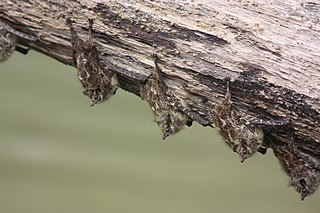
The proboscis bat is a species of bat found in South America and Central America. Other common names include long-nosed proboscis bat, sharp-nosed bat, Brazilian long-nosed bat. and river bat. It is the only species in the genus Rhynchonycteris.

The little white-shouldered bat is a species of bat from South and Central America. It is the only species within its genus, the name of which translates as "reaper" or "destroyer".
The eastern broad-nosed bat or Orion broad-nosed bat is a species of vespertilionid bat. It is found only in Australia, east of the Great Dividing Range, from about Rockhampton to Melbourne, with a small isolated population on the Atherton Tablelands.

The silver-haired bat is a solitary migratory species of vesper bat in the family Vespertilionidae and the only member of the genus Lasionycteris.

The eastern small-footed bat is a species of vesper bat. It can be found in southern Ontario and Quebec in Canada and in mountainous portions of the eastern United States from New England to northern Georgia, and westward to northern Arkansas. It is among the smallest bats in eastern North America and is known for its small feet and black face-mask. Until recently, all North American small-footed Myotis were considered to be "Myotis leibii". The western population is now considered to be a separate species, Myotis ciliolabrum. The Eastern small-footed bat is rare throughout its range, although the species may be locally abundant where suitable habitat exists. Studies suggest white-nose syndrome has caused declines in their populations. However, most occurrences of this species have only been counted within the past decade or two and are not revisited regularly, making their population status difficult to assess. Additionally, most bat populations in the Eastern U.S. have been monitored using surveys conducted in caves and mines in the winter, but Eastern small-footed bats hibernate in places that make them unlikely to be encountered during these surveys. Perhaps as a result, the numbers of Eastern small-footed bats counted in winter tend to be low and they are relatively variable compared to other species of bats. Many biologists believe the species is stable, having declined little in recent times, but that it is vulnerable due to its relatively restricted geographic range and habitat needs.

The greater short-nosed fruit bat, or short-nosed Indian fruit bat, is a species of megabat in the family Pteropodidae found in South and Southeast Asia.
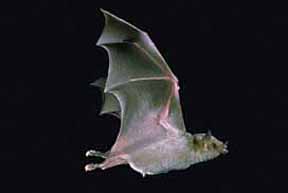
The greater long-nosed bat or Mexican long-nosed bat is a species of bat in the family Phyllostomidae. It is found in Mexico and the United States. It chiefly consumes pollen and nectar, particularly from agave plants and cacti. Its habitat includes desert scrub and open woodlands, however, it is threatened by habitat loss.

Fernandez's sword-nosed bat is a species of bat in the family Phyllostomidae. It is the smallest species of the Lonchorhina genus. It is endemic to Venezuela. In 2013, Bat Conservation International listed this species as one of the 35 species of its worldwide priority list of conservation. It is threatened by habitat loss. It derives its scientific name from a Venezuelan zoologist, Dr. Alberto Fernandez Badillo, whose research focused on vampire bats, in particular.
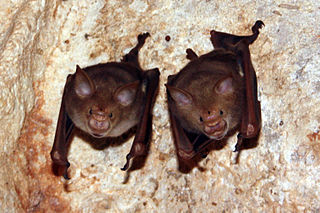
The Hipposideridae are a family of bats commonly known as the Old World leaf-nosed bats. While it has often been seen as a subfamily, Hipposiderinae, of the family Rhinolophidae, it is now more generally classified as its own family. Nevertheless, it is most closely related to Rhinolophidae within the suborder Yinpterochiroptera.

Stenodermatinae is a large subfamily of bats in the family Phyllostomidae.
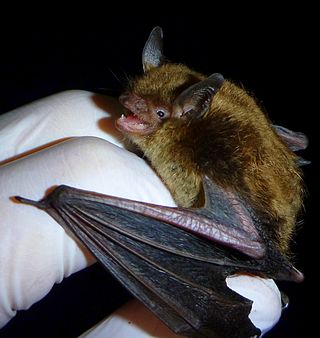
The little brown bat or little brown myotis is an endangered species of mouse-eared microbat found in North America. It has a small body size and glossy brown fur. It is similar in appearance to several other mouse-eared bats, including the Indiana bat, northern long-eared bat, and Arizona myotis, to which it is closely related. Despite its name, the little brown bat is not closely related to the big brown bat, which belongs to a different genus.
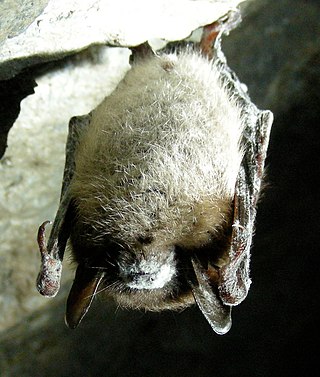
White-nose syndrome (WNS) is a fungal disease in North American bats which has resulted in the dramatic decrease of the bat population in the United States and Canada, reportedly killing millions as of 2018. The condition is named for a distinctive fungal growth around the muzzles and on the wings of hibernating bats. It was first identified from a February 2006 photo taken in a cave located in Schoharie County, New York. The syndrome has rapidly spread since then. In early 2018, it was identified in 33 U.S. states and seven Canadian provinces; plus the fungus, albeit sans syndrome, had been found in three additional states. Most cases are in the eastern half of both countries, but in March 2016, it was confirmed in a little brown bat in Washington state. In 2019, evidence of the fungus was detected in California for the first time, although no affected bats were found.
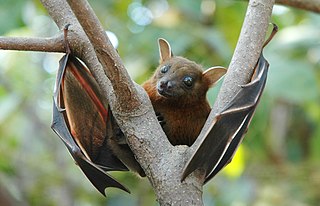
The lesser short-nosed fruit bat is a species of megabat within the family Pteropodidae. It is a small bat that lives in South Asia and Southeast Asia. It weighs between 21 and 32 grams, and measures 70 to 127 millimetres. It occurs in many types of habitat, but most frequently in disturbed forest, including lower montane forest and tropical lowland rain forest, plus gardens, mangroves, and vegetation on beaches.

Bats are flying mammals of the order Chiroptera. With their forelimbs adapted as wings, they are the only mammals capable of true and sustained flight. Bats are more agile in flight than most birds, flying with their very long spread-out digits covered with a thin membrane or patagium. The smallest bat, and arguably the smallest extant mammal, is Kitti's hog-nosed bat, which is 29–34 millimetres in length, 150 mm (6 in) across the wings and 2–2.6 g in mass. The largest bats are the flying foxes, with the giant golden-crowned flying fox reaching a weight of 1.6 kg and having a wingspan of 1.7 m.

















